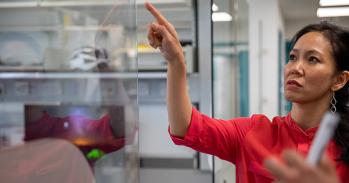
Cambridge researchers are jointly leading the first UK trial to test the benefits of proton beam therapy for certain patients with breast cancer.
Cambridge researchers are jointly leading the first UK trial to test the benefits of proton beam therapy for certain patients with breast cancer.
Standard breast radiotherapy is really effective for most people with very few side effects, but there is a small group of patients for whom proton beam therapy may be a better option
Charlotte Coles
The trial will compare proton beam therapy – which can target radiotherapy beams more precisely – with standard radiotherapy for patients who are at greater risk of long-term heart problems after radiotherapy treatment. It will help to determine whether proton beam therapy can help to deliver adequate doses of radiotherapy to breast tissue, while minimising off-target radiation delivered to the heart.
The trial will enrol 192 people across a planned 22 sites in the UK. People allocated to receive proton beam therapy will be treated at either The Christie NHS Foundation Trust in Manchester or University College London Hospitals NHS Foundation Trust, with accommodation provided for those who are travelling far from home.
The PARABLE trial is being led by researchers at the University of Cambridge, Institute of Cancer Research, London, and the Royal Marsden NHS Foundation Trust and managed by the Cancer Research UK-funded Clinical Trials and Statistics Unit at The Institute of Cancer Research (ICR). It is funded by a National Institute for Health and Care Research and Medical Research Council partnership. The NHS proton centres – UCLH and The Christie – also provided expert guidance on the trial protocol development.
Every year in the UK over 30,000 people with breast cancer receive radiotherapy following surgery as part of their treatment. Standard breast cancer radiotherapy uses high energy x-rays to kill cancer cells. As well as lowering the risk of cancer coming back, radiotherapy can increase survival rates.
Standard breast cancer radiotherapy is very effective for the vast majority of people and the benefits far outweigh small side effects. However, there can be a very small risk of radiotherapy leading to heart problems much later in life (less than one per cent of people treated). The risk of heart problems later in life due to breast radiotherapy maybe be higher than one per cent for a very small group of people. This is usually because their breast tissue and the lymph nodes which require radiotherapy treatment are located close to the heart, and/or because they have an increased underlying risk of developing heart problems later in life.
Professor Charlotte Coles, Professor of Breast Cancer Clinical Oncology at the University of Cambridge, Consultant Oncologist at Addenbrooke’s Hospital and Chief Investigator of the PARABLE trial, said: “Although only a very small group of people are affected by a higher risk of heart problems later in life, it can still be a serious issue. Most patients treated with radiotherapy have decades of healthy life ahead of them and we need to do everything we can to avoid possible future heart problems related to treatment.
“Standard breast radiotherapy is really effective for most people with very few side effects, but there is a small group of patients for whom proton beam therapy may be a better option.”
Proton beam therapy uses charged particles instead of X-rays to target tumours more precisely. Researchers hope it will allow doctors to deliver the required dose of radiotherapy where it’s needed, while minimising the dose of radiation delivered to the heart, and without increasing the risk of early side effects such as skin redness and changes in breast appearance.
The average radiotherapy dose that the heart is likely to receive from the radiotherapy planning scan can be estimated and together with age and other medical history, this information is used to predict the potential small lifetime risk of heart problems.
Professor Judith Bliss, Director of the Cancer Research UK-funded Clinical Trials and Statistics Unit at The Institute of Cancer Research, London, which is managing the PARABLE trial, said: “The PARABLE trial will measure average dose of radiotherapy delivered to the heart to predict long-term heart damage. Using this early predictor will allow us to uncover the potential benefits of using proton beam therapy for long term heart health in years rather than decades.”
People who are predicted to have at least a two per cent or more potential lifetime risk of heart problems from radiotherapy will be invited to take part. Around 500 out of every 30,000 people who receive radiotherapy for breast cancer fall into this category. People who enter the trial will either receive standard radiotherapy or proton beam therapy.
The trial will measure radiation dose delivered to the heart as an early predictor of possible heart problems, to avoid the need for lengthy follow up for many years before results are available.
People in the trial will also record their experiences using questionnaires so that researchers can assess side-effects including skin reactions, breast pain and swelling, and other symptoms which are particularly important for patients.
Proton beam therapy has been used in other countries to treat breast cancer, but numbers of participants in these trials are small and there have been no reported trials that directly compare proton beam therapy with standard radiotherapy.
The researchers stress the importance of evaluating the benefits of proton beam therapy – which is expensive and only available in certain locations across the UK – thoroughly in a clinical trial.
Dr Anna Kirby, Consultant Clinical Oncologist at the Royal Marsden NHS Foundation Trust, Breast Cancer Radiotherapy Team Lead at The Institute of Cancer Research, London, and Radiotherapy Lead for the PARABLE trial, said: “We have already learnt a huge amount about how to optimise and standardise current breast cancer radiotherapy practices alongside optimising proton beam therapy approaches. We hope that the PARABLE trial will help us to further personalise radiotherapy treatments and ensure that people can access the radiotherapy approach that is best for them, regardless of where they live.
Adapted from a press release from The Institute of Cancer Research
Kim Jones: Patient story
Kim Jones, 44, a school caterer from Ely, was diagnosed with breast cancer in February 2022 after noticing some thickening of the skin and painful twinges in her left breast. Her GP referred her for urgent scans at the breast clinic, and after having mammograms, ultrasounds and biopsies, the diagnosis was confirmed.
Kim was then referred to Addenbrooke's Hospital in Cambridge, where she had chemotherapy followed by a mastectomy and lymph node removal. Following acceptance to the PARABLE trial, Kim's proton beam therapy commenced at The Christie on 24 October.
Kim said: "I was told I might be suitable to participate in the PARABLE trial as it would potentially benefit patients with a high risk of long-term heart complications. As I already had an issue with my heart, the trial seemed like a great idea.
"When I was told that I'd been accepted onto the trial, I felt very lucky to have the opportunity to get this treatment. Clinical trials are incredibly important as they are the best way to evaluate which treatments work the best."
"The proton beam therapy centre at The Christie is bright and spacious and feels very relaxing. My experience of being treated at The Christie so far has been superb. The staff are wonderful and seem to have thought of everything. Their care is second to none, and I feel completely safe in their hands."
Following the proton beam therapy, Kim will have further chemotherapy and hormone therapy at Addenbrooke's.
Kim is married to Mark, and they have two boys, Dylan, age 14, and Elwood, age 11. She enjoys walking, reading, live music and spending time with her family.

The text in this work is licensed under a Creative Commons Attribution 4.0 International License. Images, including our videos, are Copyright ©University of Cambridge and licensors/contributors as identified. All rights reserved. We make our image and video content available in a number of ways – as here, on our main website under its Terms and conditions, and on a range of channels including social media that permit your use and sharing of our content under their respective Terms.




